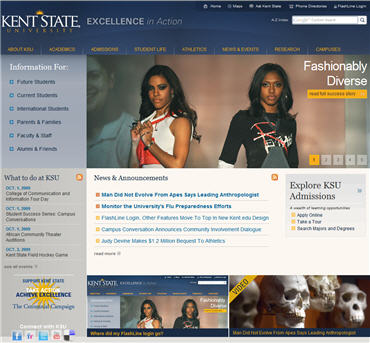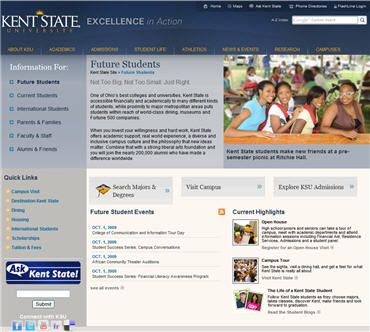

The Organization
Kent State University, located in Kent, Ohio, offers graduate, undergraduate and part-time programs to more than 33,000 enrolled students. Kent State's eight-campus network, anchored by the largest residential campus in the region, serves as a key resource for economic, social, cultural and technological advancement.
The Problem
In 2000, Kent State University Communications and Marketing (UCM) initiated a project to redesign the look and feel of the university's institutional Web site, to ensure more consistent branding and enable easier access to the content on the more than 1,100 pages of the university's site. As part of the process, Kent State researched more than a dozen content management system (CMS) solutions in order to more effectively manage the school's growing Web presence. The team reviewed research published by the Gartner Group and PC Magazine, and considered a system developed by a local third party vendor, as well as the expansion of an existing home-grown CMS system. Up until this point, content had been managed using the system developed in-house in conjunction with a variety of commercial rapid applications development tools such as DreamWeaver, Front Page and others. "Implementing a content management system and redesigning the university's Web site were important parts of a comprehensive Web improvement initiative at Kent State. The overall plan included enhancement to data integrity, system redundancy, failover protection and security. A content management solution was crucial to our desire to provide UCM editors (and others) with the ability to directly maintain and publish content to the institutional Web," said Joe Murray, Ph.D., director of New Media for Kent State.
The Solution
After approximately 10 months of reviewing content management systems including a host of applications from Rhythmyx, Documentum, OpenShare, Reefpublisher, Ektron and others, PaperThin, Inc.'s CommonSpot™ Content Server was selected for the product's rich feature set, ease of use for non-technical contributors, and the extensive product documentation and support resources provided. According to Murray, "CommonSpot offered the best value and utility for our money, and we were very pleased with the level of support and interaction we received from PaperThin technical and sales staffs during the lengthy review, repeated demonstrations and live evaluations of all products." After purchasing CommonSpot in February 2002, an in-house team comprised of 18 professional staff from the Division of Information Services (New Media Center, Network Services, Academic Computing & Technology, Help Desk) and the Division of University Relations and Development successfully implemented a complete Web improvement plan. The plan included developing the redesigned Web presence in CommonSpot and migrating thousands of pages of content into the content management system in less than seven months. The new www.kent.edu site, designed with page layouts from Mediaflow Communications, Inc. and built in CommonSpot by New Media staff, launched on August 26, 2002. The site received more than 75,000 unique visitors on the launch date.
In conjunction with the CommonSpot implementation, Kent State leveraged several additional technologies to enhance the load-balancing of Web traffic and overall system security. CommonSpot's replication features are enhanced with geographically clustered SQL servers and a host of integrated applications to facilitate Kent State's ability to manage information, network resources and users in distributed networking environments. Kent State engaged a PaperThin consultant to provide two days of Jump-Start-Training for developers, and now New Media and UCM manage all user training and account set up with a few professional staff to support new clients and departments that elect to use CommonSpot.
According to Lin Danes, Web coordinator of UCM, "Key features that have been particularly helpful include CommonSpot's ability to allow editors to schedule content activation and expiration dates, receive content freshness reminders and generate text-only versions of Web sites (to ensure ADA compliance). CommonSpot's link management features, which automatically detect and alert authors of broken links, are also well appreciated and utilized."
Danes pointed out further, "CommonSpot provides data entry forms that accept metadata during page creation and CommonSpot's architecture offers developers a means to integrate custom scripts to allow Kent State's site to incorporate automatically alternating images. A common image gallery simplifies the creation of alternate image tags for ADA compliance, and using CommonSpot, it's easy for users to upload documents in various formats, including PDFs." Other Kent State content editors find that CommonSpot features make the authoring process easy for both non-technical staff and students to manage Web changes--thus freeing up the professional technical staff's time. Finally, according to Danes, "Implementing flexible workflows in CommonSpot has ensured that all content authored by university staff regardless of campus location, department or college can receive an overall review by UCM for AP style and consistency prior to publication."
Murray indicated that in the coming months, the Web team plans to deploy more simple and advanced forms, experiment with content syndication, and utilize CommonSpot's ability to create and publish targeted newsletters--a feature that is expected to be integrated initially with a redesign of Kent State's athletic department Web site, and with other departments thereafter.
Currently two content editors from UCM and a site administrator and graphic designer from New Media maintain the university site. Other professional staff from New Media contribute to training and new site set-up as the demand for managed content continues to grow. Academic and business departments across Kent's seven regional campuses are in the process of integrating CommonSpot to manage their Web content as well. Over the next several months UCM expects an average of three new departmental Web sites to convert to CommonSpot each week--allowing academic staff to maintain their own Web pages within a controlled framework using a variety of templates pre-designed to support the institution's branding campaign.
The Return
According to Murray, "When we initiated this project for UCM, we were well aware how difficult it was for staff on eight campuses to maintain a consistent, up-to-date institutional Web presence. We anticipated that over time a content management solution would allow us to more productively leverage staff hours spent on Web maintenance and development. We fully expected that a content management solution should support the desire to improve the timeliness of content and enhance the overall consistency of the institution's online identity and service to our faculty, students and constituents around the world. We're delighted with CommonSpot's performance to date, and we will continue to improve upon our implementation of the product in the future through our working partnership with PaperThin and collaboration with other institutions of higher education across the nation."
Technology
Configuration: 1 authoring server, 2 public (slave) servers, 2 SQL database servers, 1 development server
Operating System: Windows NT
Database: MS SQL
Site Traffic: 75,000+